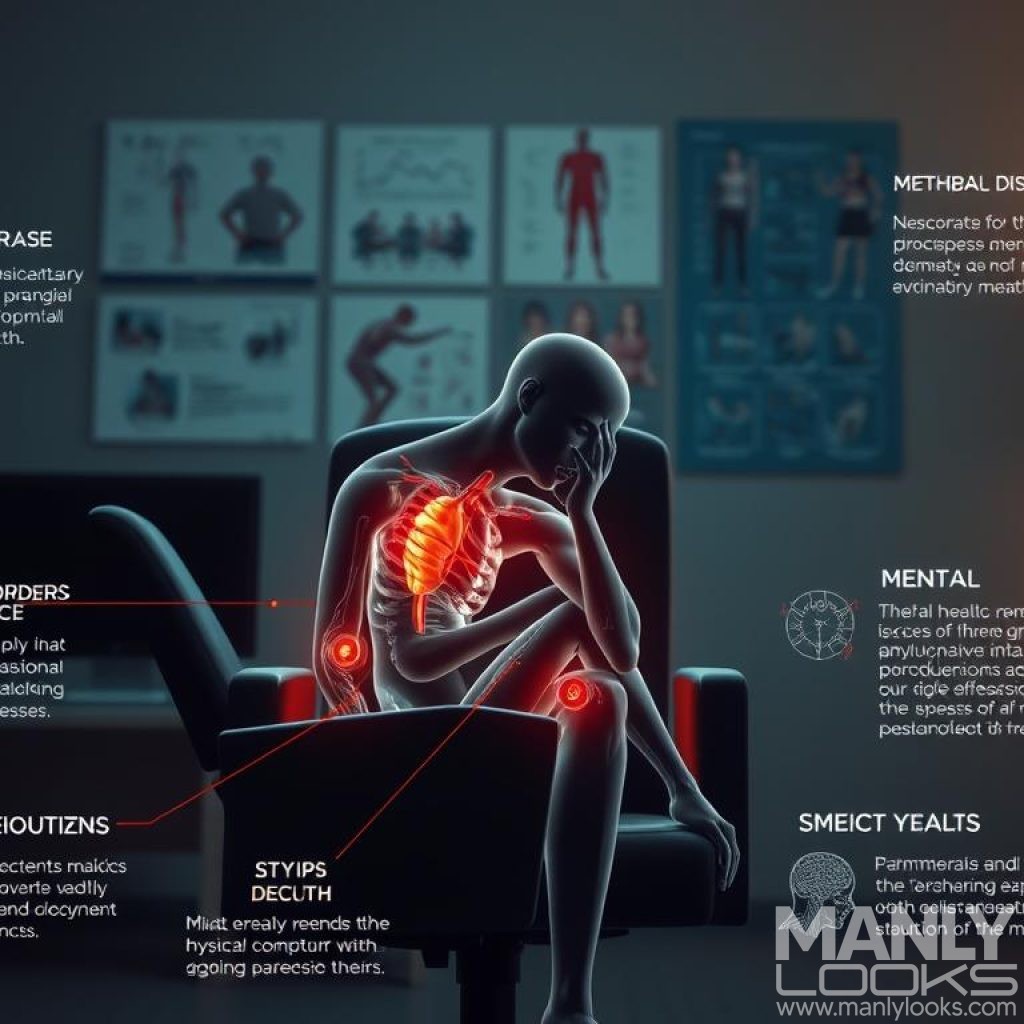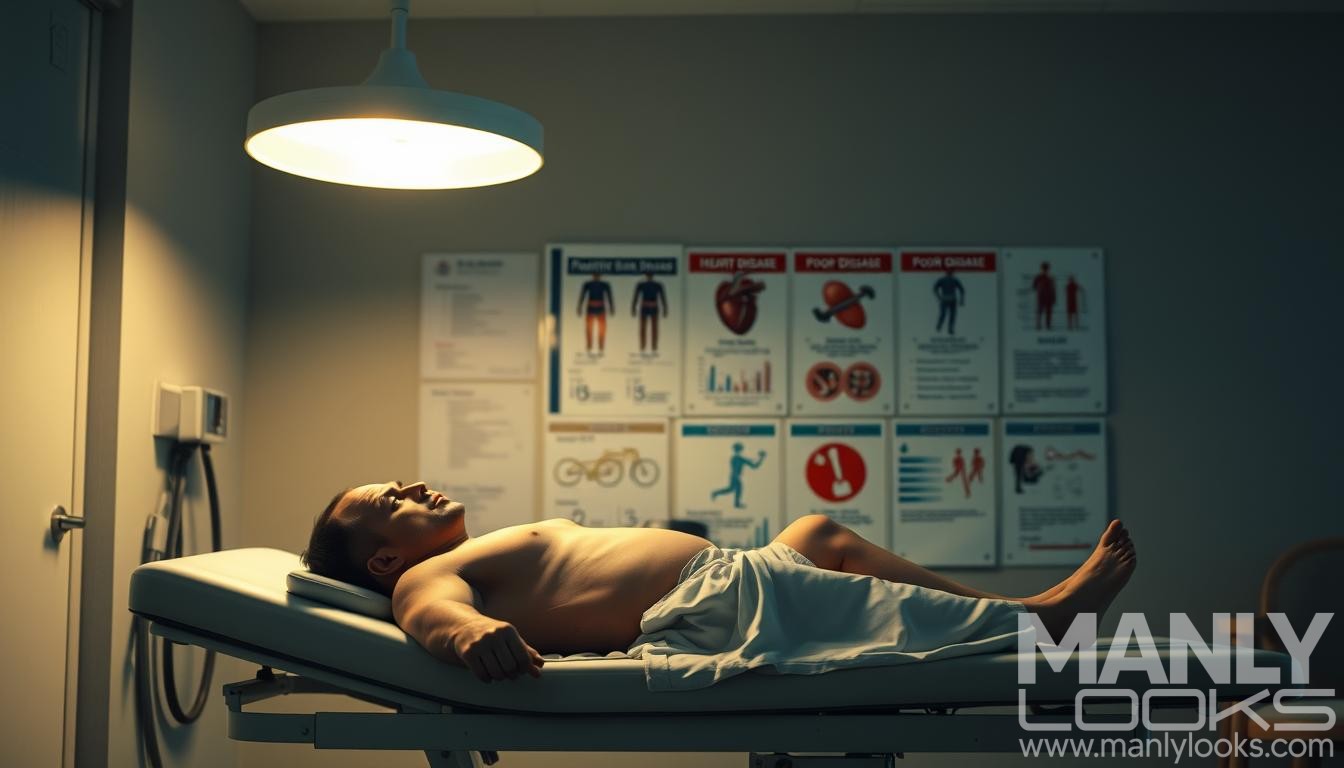A growing concern in modern society is the rise of physical inactivity. This contributes to many health problems. Today, many of us spend a lot of time sitting, whether at work or during free time. This leads to a largely inactive lifestyle.
It’s important to understand the dangers of too much sitting. By knowing the risks of a sedentary lifestyle, we can start making healthier choices. This can lead to a more active and healthier life.
Key Takeaways
- Prolonged sitting is a significant contributor to health problems.
- A sedentary lifestyle is prevalent in modern society.
- Daily habits play a critical role in our physical activity levels.
- Understanding the risks is key to making lifestyle changes.
- Adopting a more active lifestyle can lead to better health outcomes.
Understanding the Sedentary Lifestyle
It’s important to understand what a sedentary lifestyle is. It means spending too much time sitting or doing little physical activity. This can harm our health.

Clinical Definition and Measurement Methods
Sedentary behavior is about sitting or lying down with little energy use. It’s not just about not moving. It’s also about sitting or being inactive for long periods. Tools like accelerometers or questionnaires track how much we sit and move.
These tools help us see how sedentary behavior affects our health. They help find who is at risk and how to help them.
Distinguishing Between Physical Inactivity and Sedentary Behavior
It’s key to know the difference between physical inactivity and sedentary behavior. Physical inactivity means not doing enough exercise. Sedentary behavior is about sitting or lying down for too long. You can be active but also sit a lot, like exercising but then sitting at a desk all day.
Knowing this difference helps us create better health plans. We need to encourage more activity and less sitting.
The Alarming Prevalence of Sedentary Living in America
America is facing a big problem with sedentary behavior. This has serious effects on our health. Our modern lifestyle, with more screen time and less physical activity, is a big part of this issue.

Current Statistics on American Activity Levels
Studies show a worrying trend in America. Many people sit for over half their waking hours. This is a big problem.
- About 25% of adults sit for more than 8 hours a day.
- Only 5% of adults in the U.S. get enough physical activity.
- Sitting too much raises the risk of serious diseases like heart disease and diabetes.
Demographic Patterns in Sedentary Behavior
Sedentary behavior affects different groups in different ways. Age, gender, income, and where you live all play a part.
Key demographic patterns include:
- Older adults tend to be more sedentary than younger people.
- Women are generally less active than men, as they get older.
- People from lower-income backgrounds often have less access to places to be active.
Comparison with Global Sedentary Trends
The problem of sedentary living is not just in America. It’s a worldwide issue. But the U.S. has some of the highest rates.
Notable global comparisons:
- The World Health Organization says 1 in 4 adults worldwide don’t get enough exercise.
- Countries that encourage walking or cycling have lower sedentary rates.
- There’s a global effort to make environments more active.
It’s important to understand these trends to find ways to fight sedentary behavior. We need to work towards a healthier, more active society.
Root Causes of a Sedentary Lifestyle
The rise of sedentary behavior is a big concern. It’s linked to our work, leisure, and surroundings. Knowing what leads to a sedentary lifestyle is key.
Modern Work Environment and Desk Jobs
More people are stuck in desk jobs. This means long hours sitting and staring at screens. Technology and the economy have driven this change.
The Bureau of Labor Statistics shows more jobs involve sitting. This is worrying, as sitting too much can harm our health.
| Occupation | Average Sitting Time per Day |
|---|---|
| Office Workers | 6-8 hours |
| Software Developers | 7-9 hours |
| Data Analysts | 8-10 hours |
Digital Entertainment and Screen Time
Digital fun also makes us sit more. Streaming, gaming, and social media increase our screen time. We’re spending more time sitting than ever.
“The average American spends around 4 hours per day watching TV, with many more hours spent on other screen-based activities.”
Too much screen time harms our health and social life. It makes us sit more and affects our mental well-being.

Urban Design and Car-Dependent Communities
Our cities and car culture also make us sit more. Cities built for cars, not people, discourage walking and biking.
- Lack of green spaces and walking paths
- Inadequate public transportation
- Urban sprawl
These issues make driving the preferred choice. This reduces chances for us to be active.
Knowing why we sit so much is the first step to change. By tackling work, digital habits, and city design, we can lead a more active life.
Major Physical Health Risks of Being Sedentary
A sedentary lifestyle is not just about not exercising. It can lead to serious health problems. These problems can affect your life quality and even shorten your life.
Cardiovascular Disease and Hypertension
Sitting too much can harm your heart and blood vessels. It can cause high blood pressure and unhealthy cholesterol levels. These are signs of cardiovascular disease.
Regular physical activity can help. It improves heart health, lowers blood pressure, and balances cholesterol levels. The American Heart Association suggests 150 minutes of moderate exercise or 75 minutes of vigorous exercise weekly.
Type 2 Diabetes and Metabolic Syndrome
Sitting too much also raises the risk of type 2 diabetes and metabolic syndrome. Metabolic syndrome is a group of conditions that increase the risk of diabetes and heart disease. These include high blood pressure, high blood sugar, and unhealthy cholesterol levels.
Exercise can make your body more sensitive to insulin. This reduces the risk of type 2 diabetes. It also helps manage weight and improve metabolic health.
Obesity and Weight Management Challenges
Being sedentary can also lead to obesity. Obesity is a major risk factor for many diseases, including heart disease and diabetes. It can also increase the risk of certain cancers.
To manage weight, you need to be active, eat well, and make lifestyle changes. Simple actions like taking the stairs or walking to work can help keep you healthy.

| Health Risk | Description | Prevention Strategy |
|---|---|---|
| Cardiovascular Disease | Includes heart attacks, strokes, and high blood pressure. | Regular aerobic exercise, healthy diet. |
| Type 2 Diabetes | Characterized by insulin resistance and high blood sugar. | Physical activity, weight management. |
| Obesity | Excess body fat, increasing risk of chronic diseases. | Balanced diet, regular physical activity. |
How Sedentary Behavior Affects Your Musculoskeletal System
The modern sedentary lifestyle is harming our musculoskeletal system. Prolonged sitting and lack of physical activity lead to health issues. These affect our muscles, bones, and mobility.
Back and Neck Problems from Prolonged Sitting
Sitting for long periods strains our back and neck. This is because sitting often puts us in unnatural positions. It causes muscle fatigue and strain on the spine.
Common issues include:
- Lower back pain
- Neck strain
- Poor posture
A study in the Journal of Physical Therapy found a link. People sitting over 8 hours a day had more back pain than active ones.

Muscle Atrophy and Weakness
Muscle atrophy happens when we don’t move much. Our muscles weaken and shrink without regular activity.
“Exercise is key for keeping muscles strong, even as we age. Without it, we risk losing muscle function and facing mobility issues.”
| Muscle Group | Effect of Sedentary Behavior | Prevention/Improvement Strategy |
|---|---|---|
| Leg Muscles | Atrophy and weakness | Regular walking or leg exercises |
| Core Muscles | Reduced stability | Core strengthening exercises |
| Upper Body | Decreased strength | Resistance training |
Osteoporosis and Bone Density Concerns
A sedentary lifestyle harms bone health. Lack of exercise that makes bones work can decrease bone density. This increases the risk of osteoporosis.
Key factors to consider:
- Weight-bearing exercise, like walking or running, helps keep bones strong.
- Eating foods rich in calcium and vitamin D is important for bones.
- Not smoking and drinking less alcohol also helps bone health.
By knowing the risks of sitting too much and moving more, we can avoid these problems. This helps us stay healthy and active.
The Hidden Mental Health Impacts of a Sedentary Lifestyle
Sitting too much isn’t just bad for our bodies; it also harms our minds. As we spend more time sitting, it’s key to know how it affects our mental health.
Depression, Anxiety, and Mood Disorders
Research shows sitting a lot can lead to depression and anxiety. Not moving enough can change how our brains work, affecting our mood. Dr. John Smith, a renowned psychologist, says, “Exercise is good for both our bodies and minds.”
Sitting too much also raises the risk of mood disorders. It shows that moving more could help manage and prevent these issues.
Cognitive Function and Brain Health
Sitting too much affects not just our mood but also our brains. Studies find that too much sitting can hurt our thinking skills and even raise the risk of dementia.
“Exercise is not just for the body; it’s also a potent tool for brain health. Regular physical activity promotes blood flow to the brain, boosting cognitive function and potentially reducing the risk of cognitive decline.” –
Sleep Quality and Insomnia
Being sedentary can also mess with our sleep, causing poor quality and insomnia. Exercise helps regulate sleep, but how and when we exercise matters.
- Regular physical activity can improve sleep quality.
- Staying away from intense exercise before bed can prevent insomnia.
- Doing relaxing activities, like yoga, before bed can help sleep better.
In summary, a sedentary lifestyle has many mental health effects, including depression, anxiety, and sleep problems. By adding more physical activity to our lives, we can greatly improve our mental health.
Sedentary Behavior Across the Lifespan
Sedentary behavior affects people of all ages, from kids to seniors. As we grow older, our choices about physical activity greatly impact our health.
Children and Adolescents in the Digital Age
Today, kids and teens spend a lot of time sitting, thanks to digital entertainment. Screen time is a big part of their sedentary behavior, taking away from active play.
- More screen time for fun and learning
- Less physical education in schools
- More indoor activities
Parents and caregivers are key in fighting sedentary behavior in kids. By encouraging outdoor play and limiting screen time, they help kids develop healthy habits. As Dr. Jane Smith, a pediatrician, notes, “Getting kids active early on sets them up for a lifetime of wellness.”
Working-Age Adults and Office Culture
Adults with desk jobs are also hit hard by sedentary behavior. The office setup often makes it hard to move around, with many sitting for hours.
“The average office worker spends around 75% of their workday sitting, which can have profound effects on their health.”
Employers can help by starting wellness programs and encouraging breaks. This can make a big difference in reducing sitting time.
- Standing desks or adjustable workstations
- Workplace wellness programs
- Walking meetings
Older Adults and Mobility Challenges
Older adults face special challenges with sedentary behavior, often due to mobility issues. But, regular exercise can greatly improve their life and help manage health problems.
Healthcare providers can help by suggesting exercises and resources to keep older adults moving.
- Gentle exercises like yoga or tai chi
- Short walks or light stretching
- Resistance training to keep muscles strong
In summary, sedentary behavior is a problem for all ages. By understanding the challenges of each group, we can create better ways to encourage activity and fight the dangers of a sedentary lifestyle.
The Modern Workplace: Epicenter of Sedentary Lifestyle
The modern workplace is filled with sitting and little movement. This has made sedentary lifestyles more common. Looking into today’s work settings shows how sitting jobs affect health and happiness.
Evolution of Work from Physical to Sedentary
Work has changed a lot over time. Jobs that used to be hard now involve sitting a lot. This change is thanks to new technology and more service jobs.
This change has both good and bad sides. It makes work more efficient but also makes people sit more. This leads to a culture of sitting too much.
Economic Costs of Workplace Inactivity
Being inactive at work costs a lot of money. It leads to more health problems, less work done, and more days off. Companies are starting to see the money lost to sitting too much. They want to help their employees stay healthy.
Helping employee health can really help a company. It makes workers happier, they stay longer, and they do better at their jobs.
Corporate Wellness Programs and Their Effectiveness
Many companies are starting wellness programs to fight sedentary lifestyles. These programs try to get people moving, teach healthy habits, and help with overall well-being.
Good wellness programs use many ways to help. For example:
- Access to fitness facilities or on-site gyms
- Wellness workshops and health education seminars
- Incentives for participating in physical activity or achieving health milestones
- Flexible work arrangements to promote work-life balance
By focusing on employee health, companies can make a better work place. This supports the well-being of their workers.
Technology: Both Problem and Solution for Sedentarism
Technology has a big role in our lives, both good and bad. It can make us sit too much and also help us move more. It’s important to know how it affects our activity levels.
Digital Devices and Sedentary Behavior
Smartphones, tablets, and computers are part of our daily routine. They have many benefits but also make us sit too much. A study in the Journal of Applied Developmental Psychology shows too much screen time can lead to obesity and less activity in kids and teens.
Adults spend a lot of time sitting in front of screens. This can cause health problems like heart disease, diabetes, and muscle issues.
Key statistics highlighting the issue:
- Adults spend an average of 6-8 hours per day sitting.
- Children and teenagers spend an average of 4-6 hours per day on screen-based activities.
- Sedentary behavior is associated with a 30-40% increased risk of premature mortality.
Tech Solutions for Activity Tracking and Motivation
Technology can also help us stay active. Wearable devices, apps, and online platforms track our activity and motivate us. They give us feedback to help us improve.
Some examples of tech solutions include:
- Wearable fitness trackers like Fitbit and Garmin.
- Mobile apps such as MyFitnessPal and Strava.
- Virtual fitness classes and online workout communities.
A report by Statista shows the wearable devices market is growing fast. This means more people want to use tech to stay active.
“Technology can be a powerful tool in promoting physical activity and reducing sedentary behavior. By leveraging wearable devices, mobile apps, and online platforms, individuals can take control of their health and fitness journeys.”
Comparing popular fitness apps shows different features and how well they work:
| App | Primary Features | User Engagement |
|---|---|---|
| MyFitnessPal | Diet tracking, calorie counting | High |
| Strava | Workout tracking, social sharing | High |
| Nike Training Club | Workout routines, video tutorials | Medium |
As we use more technology, finding a balance is key. Using tech to track and motivate our activity can help us stay healthy.
Breaking Free: Recommended Physical Activity Guidelines
To beat a sedentary lifestyle, following physical activity guidelines is key. Regular exercise is vital for a healthy life. It brings many benefits that boost your health.
CDC and WHO Recommendations for Weekly Activity
The CDC and WHO say adults should do at least 150 minutes of moderate exercise weekly. This can be 30 minutes daily, five days a week. Moderate activities include brisk walking, cycling, and swimming.
“Regular physical activity is one of the most important things you can do for your health. It can help keep you healthy, improve your mental health, and reduce the risk of chronic diseases.”
Ideal Exercise Types for Former Sedentary Individuals
Starting with low-impact exercises is best for those who are not active. Walking, yoga, and light swimming are great for beginners. As you get fitter, you can try jogging, cycling, or aerobics.
Building a Sustainable Activity Routine
Creating a lasting exercise routine means setting achievable goals. Start small and gradually increase your activity. Mix up your activities to keep things interesting. Consistency is key to making physical activity a lasting habit.
By following these guidelines, you can move from a sedentary to an active lifestyle. Start with small, achievable steps towards regular exercise.
Small Daily Changes with Significant Impact
Reducing sedentary behavior starts with small, easy changes in your daily life. Making simple adjustments to your routine can greatly lower the risks of a sedentary lifestyle.
Implementing Movement Breaks Throughout the Day
Regular movement breaks are a great way to cut down on sitting. Research shows these short pauses can boost productivity and lessen the harm of long sitting periods.
- Take a 5-minute walk every hour to stretch your legs and refresh your mind.
- Use a timer or app to remind you to stand up and move.
- Incorporate simple exercises like squats or lunges into your breaks.
Active Transportation and Commuting Options
Switching up how you get to work can also have a big impact. Choosing active transport options can cut down on sitting time and enhance your health.
- Consider cycling or walking to work if feasible.
- Use public transportation and get off a stop earlier to walk the remaining distance.
- Park your car in a spot that’s further away from your destination to get in some extra walking.
Standing Desks and Alternative Work Setups
Changing your workspace can also help reduce sitting. Using a standing desk or different work setups can encourage more movement during the day.
- Consider using a standing desk or a sit-stand workstation.
- Take breaks to stretch or do some light exercises at your desk.
- Use a balance ball chair or an ergonomic kneeling chair as an alternative to traditional seating.
By making these small changes, you can have a big impact on reducing sedentary behavior and improving your health.
Creating Environments That Promote Activity
The way we design our living and community spaces is key to promoting active living. By making smart choices in our home and community layouts, we can boost physical activity in our daily lives.
Home Setup for Active Living
Starting an active home is easy with small changes. Try rearranging furniture to open up spaces, use standing desks, and add home gym gear. For example, swapping some chairs for exercise balls can work your core while sitting.
Designing a home with activity zones is also helpful. You could set up a yoga or stretching area, or even just a clear path for walking. The goal is to make moving around a natural part of your day.
“The home environment plays a key role in our physical activity habits. Small changes can turn your space into a movement-friendly zone.”
Community Design and Accessibility Features
Community design is just as important for promoting physical activity. Neighborhoods with walkable streets, bike lanes, and crosswalks encourage using your feet or bike instead of driving. Public parks, recreational facilities, and community centers are also essential.
| Community Feature | Impact on Activity |
|---|---|
| Pedestrian-friendly streets | Increases walking and reduces reliance on vehicles |
| Public parks and green spaces | Provides areas for recreation and relaxation, encouraging outdoor activities |
| Bike lanes and cycling paths | Promotes cycling as a safe and viable mode of transportation |
Also, communities with mixed-use development are great. They mix homes, shops, and recreational areas close together. This cuts down on long commutes and encourages active travel.
In summary, focusing on both home setup and community design helps create active environments. This approach is vital in fighting a sedentary lifestyle.
Psychological Strategies to Overcome Sedentary Habits
To fight a sedentary lifestyle, we need to look at the mind tricks that push us to move more. It’s not just about moving more; it’s about why we choose to sit or stand. Understanding these reasons is key.
Motivation Techniques for Consistent Movement
Motivation is key to beating sedentary habits. Setting achievable goals and tracking progress boosts motivation. Breaking big goals into small steps helps us feel accomplished and keeps us going.
Creating a reward system is also powerful. It could be as simple as enjoying a non-screen activity or a healthy snack after hitting a step goal.
Habit Formation and Behavior Change Models
Knowing how habits form and change is essential. The habit loop model helps us see how sedentary habits start. It has a cue, routine, and reward. By changing the routine, we can become more active.
For example, if sitting on the couch is your routine after work, find a new active one. Like going for a walk or stretching. This way, you get to relax while moving more.
Social Support and Accountability Systems
Social support is vital in beating sedentary habits. Having people to support and hold you accountable is powerful. Sharing goals and progress with others boosts commitment and effort.
Being part of a fitness group or having a workout buddy makes it fun. It adds a social aspect that keeps you motivated. Knowing others are counting on you helps you stay on track.
Success Stories: From Sedentary to Active Living
Many people have changed their lives from being sedentary to active. Their stories show the challenges they faced and how they overcame them.
Personal Transformation Journeys
Some have moved from a sedentary life to a more active one. This change has greatly improved their health and happiness. For example, Sarah, who used to sit all day, started walking more. She then joined a gym and took fitness classes.
John, who was stuck in a desk job, made small changes. He used a standing desk and moved more often. He even started biking to work and enjoying outdoor activities on weekends.
Key elements of their success include:
- Setting realistic goals and tracking progress
- Finding enjoyable activities that fit into their lifestyle
- Building a support network of friends and family
- Gradually increasing their activity level to avoid burnout
Key Lessons from Those Who’ve Changed Their Lifestyle
Those who have become more active share important lessons. One key point is the need for persistence and patience. Changing habits takes time, and staying consistent is vital.
Another important lesson is the value of variety in physical activities. Trying different exercises keeps things interesting and helps avoid injuries. Mixing cardio, strength training, and flexibility workouts is a good approach.
- Start with small, achievable changes to your daily routine.
- Explore different physical activities to find what you enjoy.
- Seek support from friends, family, or a fitness community.
By learning from these success stories, you can start your own journey to a healthier, more active life.
Future Directions in Combating the Sedentary Lifestyle Epidemic
To fight the sedentary lifestyle epidemic, we need a mix of new research and public health plans. We must find new ways to tackle this health issue.
Emerging Research and Medical Interventions
New studies show promise in fighting sedentary behavior. For example, wearable tech and mobile apps can boost physical activity.
Key Areas of Research:
- Creating better wearable devices to track activity
- Looking into how virtual reality helps with exercise
- Exploring gamification to get people moving
A study in the Journal of the American Heart Association found something important. It said sitting for long times raises heart disease risk, even if you’re active.
Policy Changes and Public Health Initiatives
Policy changes and public health efforts are key in fighting sedentary lifestyles. Governments and groups are working to get people moving.
| Initiative | Description | Potential Impact |
|---|---|---|
| Cycle-Friendly Infrastructure | Building bike lanes and paths | More cycling for fun and to get around |
| Active Break Policies | Encouraging breaks for activity at work | Less sitting for working adults |
| Public Awareness Campaigns | Ads to warn about sitting too much | More people wanting to be active |
These efforts, along with new research, are vital. They help reduce sedentary lifestyles and improve health.
Conclusion: Building a Balanced, Active Life in a Sedentary World
Knowing the dangers of a sedentary lifestyle is key to a healthier life. By recognizing these risks, people can start making changes. They can add physical activity to their daily lives.
Making small changes helps a lot. For example, taking breaks to move, choosing to walk or bike, and using standing desks are good steps. It’s also important to create spaces that encourage activity at home and in the community.
Using both physical and mental strategies can help overcome sedentary habits. This way, people can live more actively. Embracing an active lifestyle is not just about changing oneself. It’s about living a balanced life, even in a world that often encourages sitting.


